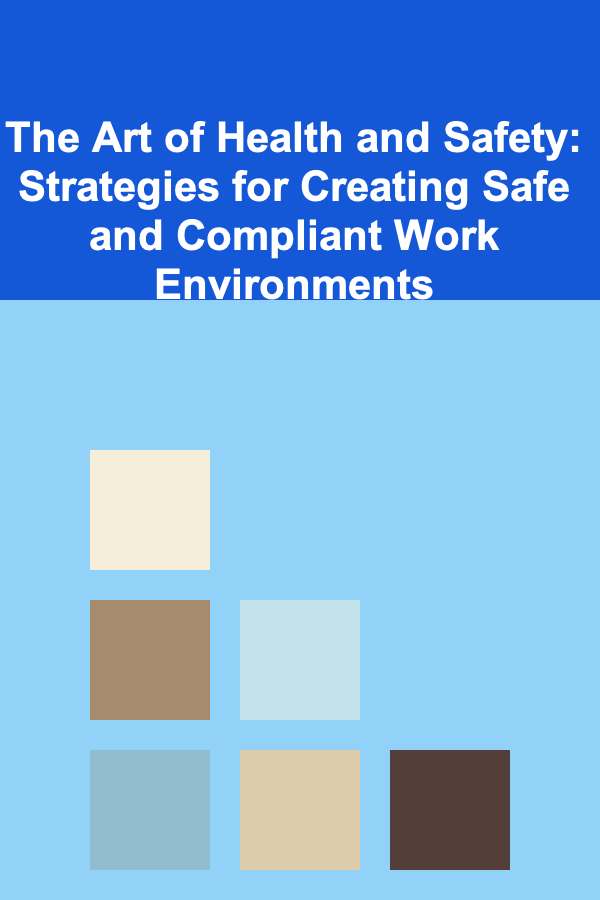
The Art of Health and Safety: Strategies for Creating Safe and Compliant Work Environments
ebook include PDF & Audio bundle (Micro Guide)
$12.99$7.99
Limited Time Offer! Order within the next:

Creating a safe and compliant work environment is an ongoing process that requires a blend of strategic planning, practical measures, and a culture that prioritizes the well-being of employees. The art of health and safety lies not only in enforcing rules but in fostering a work culture that inherently values safety at all levels. This actionable guide will provide in-depth strategies for designing and implementing a health and safety system that protects workers while ensuring regulatory compliance.
Understanding the Foundation of Health and Safety
Health and safety in the workplace are paramount not just for legal compliance but for the overall productivity and reputation of an organization. Employees are the most valuable asset in any business, and maintaining their safety is essential for the continuity and success of the enterprise. A safe work environment prevents accidents, promotes health, reduces absenteeism, and enhances morale. This is why health and safety should be regarded as a dynamic aspect of organizational culture rather than just a set of regulations to be followed.
Legal Requirements and Regulations
Before diving into specific strategies, it's important to understand that health and safety regulations vary by country, industry, and the type of work performed. Health and Safety Officers (HSOs) must stay updated on the relevant laws and frameworks, such as the Occupational Safety and Health Administration (OSHA) in the U.S., the Health and Safety Executive (HSE) in the UK, or the European Union's health and safety directives. Compliance is not optional; failure to adhere to regulations can result in severe fines, legal liability, and damage to the organization's reputation.
Strategic Approaches to Building a Safe Work Environment
The strategies for creating a safe work environment should be multi-faceted, addressing everything from physical hazards to mental health. The key to success is a combination of proactive planning, continuous monitoring, and fostering a safety-first culture.
1. Conducting Comprehensive Risk Assessments
Risk assessment is the cornerstone of any health and safety strategy. Without identifying potential hazards, it's impossible to manage them effectively. A thorough risk assessment allows organizations to anticipate risks before they manifest into accidents.
Steps to Conduct a Risk Assessment:
- Identify Hazards: Hazards can be physical, chemical, biological, ergonomic, or psychological. Identify all potential risks, from machinery and tools to work schedules that may lead to fatigue or stress.
- Evaluate Risks: Assess how likely each hazard is to cause harm and the potential severity of the consequences. This helps in prioritizing which risks to address first.
- Implement Control Measures: For each identified hazard, put appropriate control measures in place, such as implementing machinery guards, providing personal protective equipment (PPE), offering ergonomic training, or changing workflows to minimize stress.
- Review and Revise: Risk assessments should not be a one-time event. They must be regularly reviewed, especially after incidents or when new equipment or work practices are introduced.
By conducting regular and thorough risk assessments, you can address potential dangers before they lead to accidents or injuries.
2. Establishing Clear Health and Safety Policies
Policies provide the framework that governs health and safety activities within the workplace. Having clear, accessible policies ensures that all employees know what is expected of them and how to respond to emergencies. These policies should cover a range of areas, including:
- Emergency Response Procedures: Clear guidelines on how to respond to different types of emergencies (fires, medical emergencies, natural disasters, etc.).
- PPE Guidelines: Instructions on when and how to use protective gear, and what equipment is necessary for different tasks.
- Incident Reporting and Investigation: A transparent system for reporting safety incidents, including accidents, near-misses, or unsafe conditions. It should outline the steps taken to investigate and rectify the root cause.
- Employee Well-being: Policies addressing mental health, stress management, and work-life balance, recognizing that overall employee well-being is just as important as physical safety.
3. Fostering a Safety-First Culture
The success of any safety strategy ultimately depends on how well it is embedded in the company culture. A "safety-first" mindset should be ingrained into every layer of the organization, from the executive team to front-line employees.
Key Elements of Building a Safety Culture:
- Leadership Commitment: Leaders must set the tone by demonstrating a commitment to health and safety through actions, not just words. When leaders are actively involved in safety initiatives, employees are more likely to adopt similar behaviors.
- Employee Involvement: Encouraging employees to participate in safety programs fosters a sense of ownership and responsibility. This could include safety committees, hazard identification teams, or offering suggestions for improving safety protocols.
- Open Communication: Employees should feel comfortable raising concerns without fear of retaliation. Regular safety meetings, anonymous suggestion boxes, or open-door policies can help in cultivating this transparency.
- Recognition and Rewards: Positive reinforcement encourages adherence to safety practices. Consider recognizing employees or teams who consistently follow safety protocols, report hazards, or contribute to improving the safety culture.
4. Providing Ongoing Training and Education
Health and safety education should not be a one-time event. Continuous learning is vital for keeping employees aware of new safety risks and regulations. Training sessions should be tailored to the specific needs of different departments, as safety hazards vary by role.
Key Training Areas Include:
- Induction Training: Every new employee should undergo health and safety induction as part of their onboarding process. This ensures they understand the specific hazards of their role and how to mitigate them.
- Specialized Training: For employees working with hazardous substances, heavy machinery, or complex electrical systems, more specialized training is required. Regularly update employees on new technologies or safety equipment.
- Refresher Courses: Safety standards evolve, and workers need to stay up-to-date. Conduct periodic refresher courses to address changes in the law, technology, or internal processes.
- Mental Health and Well-being: Provide training on stress management, recognizing signs of burnout, and supporting colleagues who may be experiencing mental health difficulties.
5. Implementing Incident Reporting and Investigation Systems
Creating a transparent system for reporting and investigating incidents is essential for continuous improvement. Every incident, regardless of its severity, should be reported and analyzed to identify underlying causes.
Steps for Effective Incident Reporting:
- Report Forms: Simplify the process of reporting incidents, whether near-misses, minor injuries, or major accidents. The reporting system should be accessible and user-friendly.
- Root Cause Analysis: When incidents occur, conduct a thorough investigation to identify the root causes. This may involve interviewing employees, reviewing safety protocols, and examining the physical environment.
- Corrective Actions: Once a root cause has been identified, take corrective action. This could involve retraining staff, improving equipment, or changing safety policies. Ensure these actions are followed through and track their effectiveness.
- Feedback Loop: After corrective actions are implemented, feedback from employees should be solicited to evaluate the effectiveness of the changes. Continuous feedback helps fine-tune safety practices over time.
6. Regular Inspections and Audits
Regular workplace inspections ensure that safety measures are being adhered to and provide an opportunity to spot potential hazards before they escalate into problems. These inspections should be systematic and documented.
Key Considerations for Workplace Inspections:
- Checklists: Use detailed inspection checklists that cover all potential hazards. These should be tailored to the specific risks of each department or area.
- Third-Party Audits: Consider bringing in external health and safety auditors to provide an unbiased perspective on your safety practices.
- Follow-Up: Inspections should lead to actionable outcomes. If hazards are identified, corrective measures should be implemented promptly, with a follow-up inspection to ensure compliance.
Continuous Improvement and Adaptation
Health and safety are dynamic processes. Regulations change, technologies evolve, and new risks emerge. As a result, it is essential to continually evaluate and adapt safety practices.
Methods for Continuous Improvement:
- Benchmarking: Compare your organization's health and safety practices with those of industry leaders or peers. This can help identify areas for improvement and best practices that you can adopt.
- Post-Incident Review: After any significant incident, conduct a thorough review to learn from the experience. Analyze what went wrong, what could have been done differently, and how to prevent similar issues in the future.
- Employee Feedback: Create mechanisms for employees to provide feedback on health and safety practices. Regular surveys or focus groups can be an invaluable source of information for identifying gaps in your system.
Conclusion
The art of health and safety in the workplace is not just about adhering to regulations---it's about creating an environment where employees feel safe, valued, and supported. By implementing comprehensive risk assessments, clear policies, continuous training, and fostering a culture of safety, organizations can reduce accidents and injuries, improve morale, and increase productivity. Health and safety officers must act as both managers and advocates, constantly working to improve the system and ensuring that safety remains at the core of the organization's values.
Ultimately, a safe and compliant work environment is the result of proactive leadership, diligent planning, and a deep commitment to the well-being of all employees. When safety is woven into the fabric of the workplace culture, it becomes an integral part of the company's identity, ensuring long-term success and growth.

How to Create a Checklist for Cleaning Your Bathroom Efficiently
Read More
How to Create a Customer Feedback Management Checklist for Responding to Negative Feedback
Read More
How to Incorporate Modern Design Trends in Your Home Staging
Read More
How To Manage Kids' Arguments and Disagreements
Read More
How to Manage Multiple Data Entry Projects Efficiently
Read More
How To Practice Journaling with Stoic Prompts
Read MoreOther Products

How to Create a Checklist for Cleaning Your Bathroom Efficiently
Read More
How to Create a Customer Feedback Management Checklist for Responding to Negative Feedback
Read More
How to Incorporate Modern Design Trends in Your Home Staging
Read More
How To Manage Kids' Arguments and Disagreements
Read More
How to Manage Multiple Data Entry Projects Efficiently
Read More